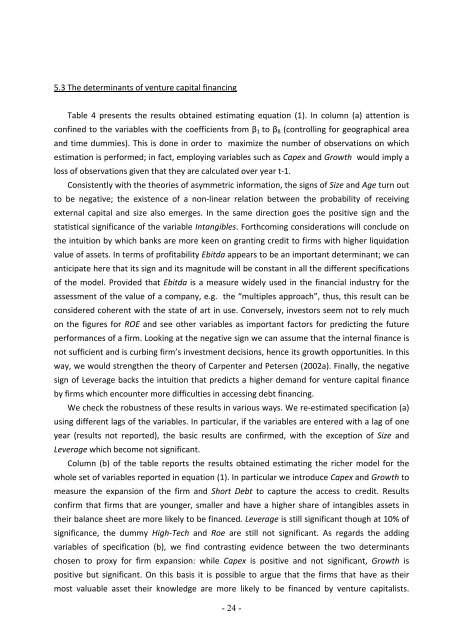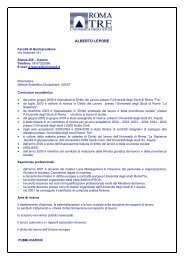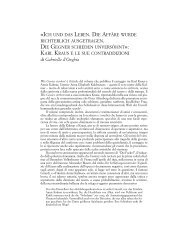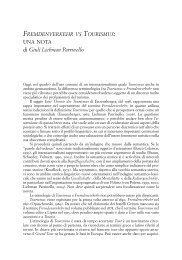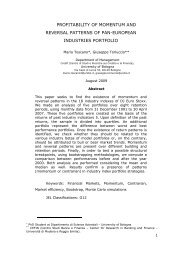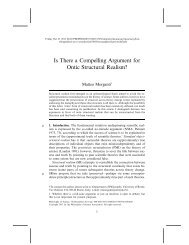Determinants and effects of Venture Capital and Private Equity ...
Determinants and effects of Venture Capital and Private Equity ...
Determinants and effects of Venture Capital and Private Equity ...
Create successful ePaper yourself
Turn your PDF publications into a flip-book with our unique Google optimized e-Paper software.
5.3 The determinants <strong>of</strong> venture capital financing<br />
Table 4 presents the results obtained estimating equation (1). In column (a) attention is<br />
confined to the variables with the coefficients from β1 to β8 (controlling for geographical area<br />
<strong>and</strong> time dummies). This is done in order to maximize the number <strong>of</strong> observations on which<br />
estimation is performed; in fact, employing variables such as Capex <strong>and</strong> Growth would imply a<br />
loss <strong>of</strong> observations given that they are calculated over year t‐1.<br />
Consistently with the theories <strong>of</strong> asymmetric information, the signs <strong>of</strong> Size <strong>and</strong> Age turn out<br />
to be negative; the existence <strong>of</strong> a non‐linear relation between the probability <strong>of</strong> receiving<br />
external capital <strong>and</strong> size also emerges. In the same direction goes the positive sign <strong>and</strong> the<br />
statistical significance <strong>of</strong> the variable Intangibles. Forthcoming considerations will conclude on<br />
the intuition by which banks are more keen on granting credit to firms with higher liquidation<br />
value <strong>of</strong> assets. In terms <strong>of</strong> pr<strong>of</strong>itability Ebitda appears to be an important determinant; we can<br />
anticipate here that its sign <strong>and</strong> its magnitude will be constant in all the different specifications<br />
<strong>of</strong> the model. Provided that Ebitda is a measure widely used in the financial industry for the<br />
assessment <strong>of</strong> the value <strong>of</strong> a company, e.g. the “multiples approach”, thus, this result can be<br />
considered coherent with the state <strong>of</strong> art in use. Conversely, investors seem not to rely much<br />
on the figures for ROE <strong>and</strong> see other variables as important factors for predicting the future<br />
performances <strong>of</strong> a firm. Looking at the negative sign we can assume that the internal finance is<br />
not sufficient <strong>and</strong> is curbing firm’s investment decisions, hence its growth opportunities. In this<br />
way, we would strengthen the theory <strong>of</strong> Carpenter <strong>and</strong> Petersen (2002a). Finally, the negative<br />
sign <strong>of</strong> Leverage backs the intuition that predicts a higher dem<strong>and</strong> for venture capital finance<br />
by firms which encounter more difficulties in accessing debt financing.<br />
We check the robustness <strong>of</strong> these results in various ways. We re‐estimated specification (a)<br />
using different lags <strong>of</strong> the variables. In particular, if the variables are entered with a lag <strong>of</strong> one<br />
year (results not reported), the basic results are confirmed, with the exception <strong>of</strong> Size <strong>and</strong><br />
Leverage which become not significant.<br />
Column (b) <strong>of</strong> the table reports the results obtained estimating the richer model for the<br />
whole set <strong>of</strong> variables reported in equation (1). In particular we introduce Capex <strong>and</strong> Growth to<br />
measure the expansion <strong>of</strong> the firm <strong>and</strong> Short Debt to capture the access to credit. Results<br />
confirm that firms that are younger, smaller <strong>and</strong> have a higher share <strong>of</strong> intangibles assets in<br />
their balance sheet are more likely to be financed. Leverage is still significant though at 10% <strong>of</strong><br />
significance, the dummy High‐Tech <strong>and</strong> Roe are still not significant. As regards the adding<br />
variables <strong>of</strong> specification (b), we find contrasting evidence between the two determinants<br />
chosen to proxy for firm expansion: while Capex is positive <strong>and</strong> not significant, Growth is<br />
positive but significant. On this basis it is possible to argue that the firms that have as their<br />
most valuable asset their knowledge are more likely to be financed by venture capitalists.<br />
- 24 -


